Knocking ghost disappears.
Evening News Reporter.
Mysterious bumping noises which were claimed to be spirit messages from a man dead, have disappeared from a Salford house after a service of exorcism by two Anglican priests. The 25-minute service was held in the terraced home in Tully-street of Mrs Olive Hill, aged 38, by the Rev. Edward Dimond, of nearby St. James’s Church, and the Rev. F. W. Osborn, of St. Clement’s, Longsight, Manchester.
Neighbour Mrs Freda Roberts, aged 34, claimed the bumps which had been heard in the house for weeks were messages from her father in law. Present at the service was Mr. David Cohen, an investigator for the Manchester Psychic Research Association. Upstairs in bed was the Hill’s 11-year-old son, Alan, whom Mr Cohen told the family was being used by the spirit to communicate.
When the service was being held Mr. Jack Hill, aged 39, had to send for police to move a crowd in the street. Said Mrs. Hill: “There has not been a single noise since after the service. We hope it has gone for good.”
Manchester Evening News, 23rd February 1960.
Ex-Portadown Curate Exorcises ‘Ghost’ Noises.
Former curate-assistant of Portadown parish, Rev. E. W. Dimond, has had widespread mention in the English daily Press as a result of his being requested to investigate mysterious noises in the house of Mr and Mrs Jack Hill, who reside in his parish of St. James, Higher Broughton, Manchester. The noises began at Christmas Eve, since when the Hills have hardly had a night free from interruption as the sound of “bump, bump, bump” continued for three hours at a time.
Mr Hill, who is aged 39 years and his wife, aged 38, made a thorough search of the house without result. Mrs Hill described the noise as like an iron bouncing-ball on the ceiling. Then they called in their rector, who diagnosed the cause as supernatural and confidently observed: “Whatever it is, it will stop after the service.” This week Mr. Dimond held a service of exorcism. Over the telephone he told a “Portadown News” reporter that it had been “entirely successful.” The service he used was of his own devising and not the prescribed one. This departure was made on the suggestion of his Bishop, Dr. Greer.
Portadown News, 26th February 1960.
Poltergeist Exposed!
Photonews 3-week investigation gets historic picture of ‘bumps in the night’ in action…
and explodes myth.
By Merrick Winn.
Special assistant, Raymond Hawkey.
Around midnight on Sunday, March 6, two doctors went to a terrace house in Salford, Lancs, and took a small boy to hospital. Now certain people should feel ashamed, and some should feel disgraced, because of their superstition, ignorance and busybody tampering which for nearly three months kept this boy from medical help. And made him worse.
The boy is Alan Hill, aged 12, who lives with his parents, and his grandmother at No. 24, Tully-street, where for these three months there were bumpings and rappings in the night. They were caused, said the credulous people, by a poltergeist or “restless spirit.” Most of them enjoyed their belief.
I am telling Alan’s story, after investigating it for three weeks, because it is typical of other poltergeist stories which regularly make news and because the truth now may help expose much medieval and near-evil nonsense. The story begins at Christmas when Mr Jack Hill, machinist in his forties, and his wife Olive, 38, heard very loud noises, particularly the noise of a bouncing ball, coming from upstairs. The noises occurred most nights between 11 p.m. (Alan’s bedtime) and 1 a.m. Neighbours heard them, and even people across the street.
Mr and Mrs Hill were sleepless, distressed, and bewildered. They did not suspect alan. True, the noises stopped when they rushed up to his room, but he always seemed asleep. Then three groups of people came to help in their curious ways. The officials, the clergy, the psychical researchers. They all had one thing in common: good intentions. First the officials. The police, the gas men, the water board men, the town hall people, two head masters, and a school inspector. They found nothing and went away.
No one obeyed the first rule of investigating “poltergeists” – to look for a troubled child. No one thought that Alan, with his sensitiveness and his nervousness, might be a sick boy.
Then the Rev. Edward Dimond, 33, rector of St. James’s, Salford, announced through the BBC that he believed the noises were made by a “restless spirit.” And at around 11 p.m. on Monday, February 22, he and the Rev. Frederick Osborn, of St. Clement’s, Manchester, arrived with cassocks and crucifixes and prayer books and faith to exorcise this “spirit.” The exorcism was thorough and awesome, but not a success. These gentle men now have to face that although they tried, in their way, to help this family, their ancient faith served only to make a sick boy more afraid.
Members of the Manchester Society for Psychical Research also tried to help, sincerely, in their way. But their sincerity was, in my view, dangerous; as sincerity sometimes is. I first met Mr David Cohen, the society’s investigating officer, on the night of the exorcism service though he had already been interesting himself in the affair for some time. Mr Cohen, 45-year-old bachelor, is not typical of psychical researchers. The first step in a serious investigation would have been to make sure Alan could not make the noises himself. Mr Cohen did not take this step, nor did anyone else. Incredibly, no one ever had Alan provably in full view while the noises went on. Yet everyone agreed “it couldn’t possibly be Alan.”
Mr Cohen based his investigation on, for me, unbelievable beliefs which so far as I understood him went like this: – A “spirit” was using Alan as a medium to get messages to Mrs Freda Roberts (who lives next door). This “spirit” was “Teddy Roberts,” Mrs Roberts’s father-in-law, who died four years ago, and Mr Cohen, in order to receive the messages, had “educated” it in a tapping code. A – one tap; B- two taps; Z- 26 taps. “There’s no danger,” Mr Cohen assured me and everyone, “because the spirit entity will leave Alan alone once it has given its final message.”
The “spirit” had already, during February, delivered some messages. It said Sheffield Wednesday would win the Cup. One of the more macabre aspects of this whole affair was the neurotic excitement, the diseased delight, shown by many of the people concerned with it. Yet not all these people were unintelligent.
At this point my colleague, Raymond Hawkey, and I had heard enough and seen enough to call a doctor. The doctor came and arranged for Alan to be seen at a local hospital. Even then Mr Cohen, not boasting but believing, said: “I’ve had 20 years’ experience and I should know more than the doctors.” On February 29 the doctor asked Mr Cohen to promise not to visit Alan for a week during the preliminary medical investigation. Mr Cohen promised. But on the night of March 1 the doctor visited Alan and found Mr Cohen, with other psychical researchers, in full session, taking messages.
The doctor and the hospital consultant withdrew from the case. They felt, rightly, they could not be associated with this sort of thing. Raymond Hawkey and I heard about this and returned to Tully-street on Sunday, March 6, to find the situation greatly worsened. The mass hysteria was now cancerous. One of the neighbours told me she had seen walking footprints on the carpet with no one there. Mrs Hill said she had seen spoons flying and Alan said he had floated up to the ceiling. Mrs Hill believed this because, she said, she saw him floating up to the ceiling herself and had only just managed to haul him down by his trousers.
The noises stopped, suddenly, after one wild night when the eager crowd in the living room – neighbours, researchers and all – heard among other things the noise of heavy furniture being dragged about.
But now worse was happening. Alan was going into trance-like states several times a day – in full view of everyone – and his parents and the neighbours took this to mean he was en route for the ceiling. So they were frightened and they struggled to hold him down and threw cold water in his face. And when they did this he got violent. Hawkey and I watched one of these trances. It lasted half an hour and we saw Alan drag furniture we ourselves could drag only with effort. So this accounted for one aspect of the “poltergeist.”
We had this trance photographed to prove at last Alan was responsible for the noises and was desperately needing medical care. And we gave the photographs to the doctors to help diagnosis.
Later this same evening of March 6 Mr Cohen came. Since the trances, only he could get Alan to sleep. He had developed a friendship with the boy and he meant it kindly. But it was bad for Alan. Something had to be done quickly. Hawkey and I urged Mr and Mrs Hill to send Mr Cohen away and call back the doctors. Mr Cohen went and I think he was relieved to go (after asking Mrs Hill to write a letter expressing gratitude for all he had done). By midnight Alan was in hospital. He is still there.
And a doctor told me: “His experiences since Christmas have made him worse.” Since he has been in hospital he has admitted making the noises – a medical symptom and, of course, nothing to do with “spirits” – and he says he did it chiefly by banging a loose floorboard with the bouncy side of his outstretched hand. Alan was aware of it all, in a shadowy way, as a person hypnotised is aware. He tapped out the messages, in the code taught him by Cohen, again in this trance-like state.
So this is the “Salford poltergeist.” Almost the only people who came out well are Alan, and his parents who were helpless before those they believed must know better than they. For most of these people now there will be only disappointment. They are cheated of their eager beliefs. No spirits, no messages, no ectoplasm.
Many will say: “It was only a sick child.” They will say it, not with pity but with anger, and possibly no remorse at all. But for a few there will be real regret, and pity. Perhaps in return they may be pitied too. And forgiven.
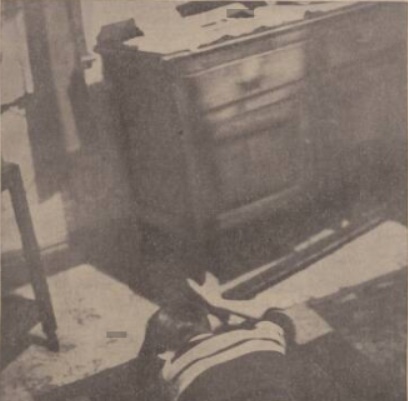
Alan Hill, in deep trance, drags heavy sideboard across room.
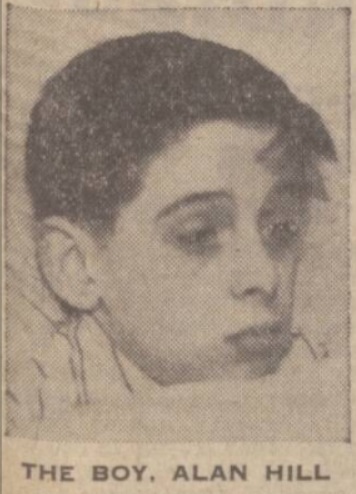
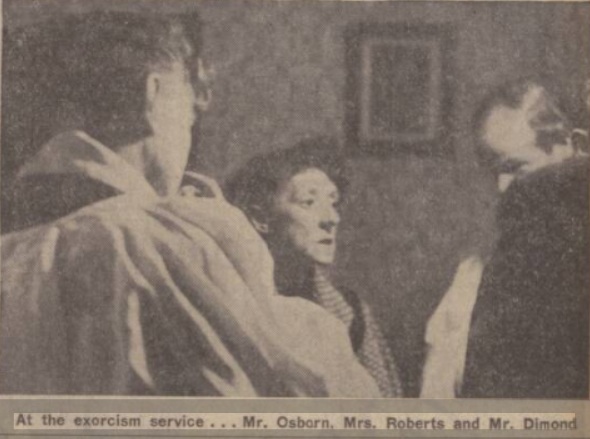
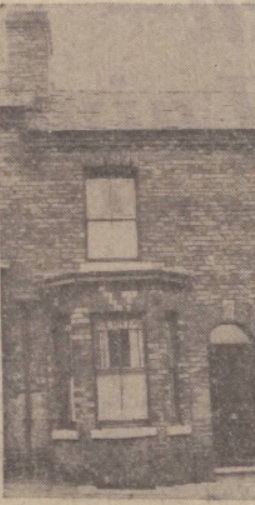
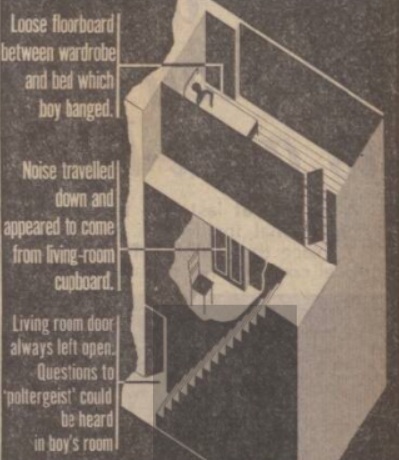
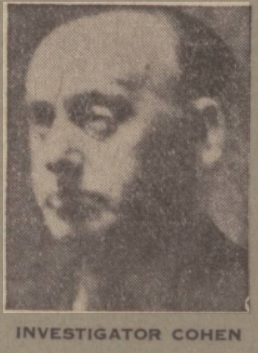
Pictures by Edward Rawlinson.
Daily Express, 18th March 1960.